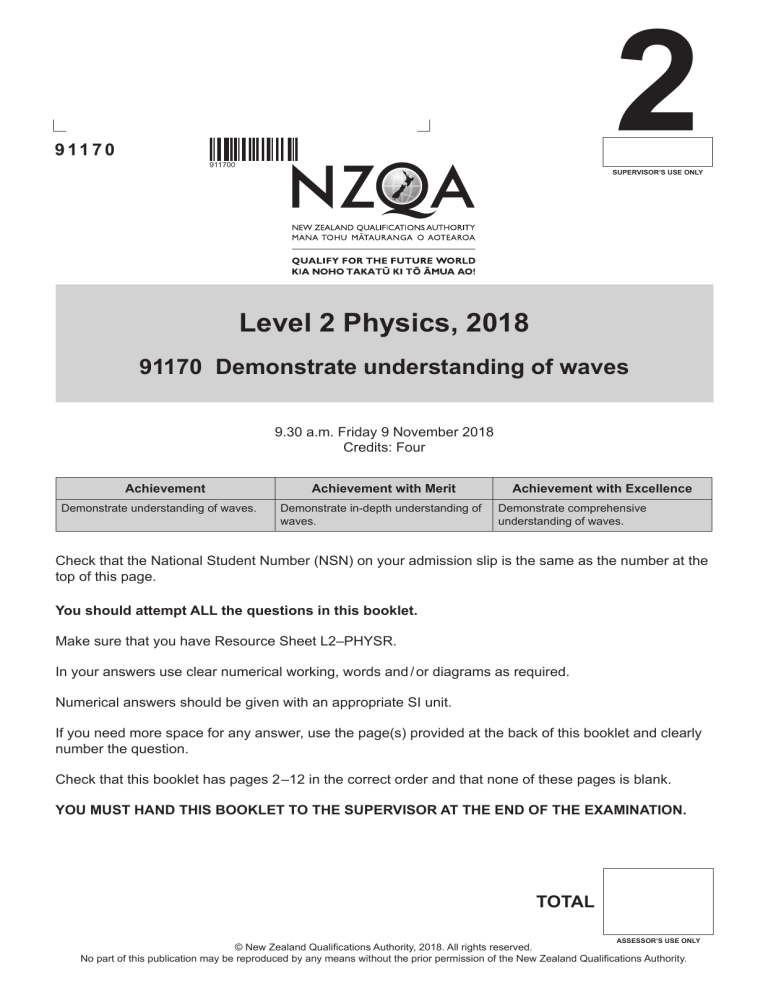
9 11 7 0
2
911700
SUPERVISOR’S USE ONLY
Level 2 Physics, 2018
91170 Demonstrate understanding of waves
9.30 a.m. Friday 9 November 2018
Credits: Four
Achievement
Demonstrate understanding of waves.
Achievement with Merit
Demonstrate in-depth understanding of
waves.
Achievement with Excellence
Demonstrate comprehensive
understanding of waves.
Check that the National Student Number (NSN) on your admission slip is the same as the number at the
top of this page.
You should attempt ALL the questions in this booklet.
Make sure that you have Resource Sheet L2–PHYSR.
In your answers use clear numerical working, words and / or diagrams as required.
Numerical answers should be given with an appropriate SI unit.
If you need more space for any answer, use the page(s) provided at the back of this booklet and clearly
number the question.
Check that this booklet has pages 2 –12 in the correct order and that none of these pages is blank.
YOU MUST HAND THIS BOOKLET TO THE SUPERVISOR AT THE END OF THE EXAMINATION.
TOTAL
ASSESSOR’S USE ONLY
© New Zealand Qualifications Authority, 2018. All rights reserved.
No part of this publication may be reproduced by any means without the prior permission of the New Zealand Qualifications Authority.
2
QUESTION ONE: THE ENLARGED EYE
ASSESSOR’S
USE ONLY
Sophie and her friend John were investigating magnifying
glasses (convex lenses). Sophie laughed at the size that
John’s eye appeared when he placed the lens over his eye.
(a) Complete the following ray diagram to show how
John’s eye (the object) appears enlarged, as in the
photo.
Clearly indicate its size and position.
www.123rf.com/photo_11597957_funnyboy-looking-through-magnifying-glass-withsurprise.htm
O
F
F
The lens has a focal length of 12 cm. John holds the lens 5 cm from his eye.
If you need
to redraw your
ray diagram,
use the diagram
on page 9.
(b) Calculate the distance the image is from the lens, and state the nature of the image produced.
(c)
If the eye (object) has a height of 2.0 cm, calculate the magnification AND the height of the
image of the eye.
Physics 91170, 2018
3
(d) John cannot see the image of his own eye by looking through the lens. He decides to put the
lens down and select one of three types of mirror – plane, convex or concave.
convex mirror
(i)
concave mirror
plane mirror
Which type of mirror would give the best upright and magnified image of his eye?
Justify your choice.
(ii) Where would John’s eye need to be positioned to get an enlarged upright image for your
choice of mirror?
(iii) Clearly explain where John’s eye would need to be positioned to obtain the largest
upright image possible for your choice of mirror.
Physics 91170, 2018
ASSESSOR’S
USE ONLY
4
QUESTION TWO: LASER IN THE JUICE
ASSESSOR’S
USE ONLY
Later, Sophie shines a green laser beam from air into a glass of juice. When she
does, she notices that the light refracts.
vlight in air= 3.00 × 108 m s–1
nair = 1.00
njuice = 1.34
(a)
Define ‘refraction’.
(b) The diagram below shows the cross-section of the glass, looking down from above, with the
juice inside. For the purpose of this question, you can assume the glass itself is very thin and
has negligible effect on the path of the light rays.
normal
thin glass
juice
If you need
to redraw your
ray diagram,
use the diagram
on page 9.
62.0°
air
(i)
Complete the diagram, clearly showing the refraction of the light ray as it enters the
juice.
(ii) Calculate the angle of refraction.
Physics 91170, 2018
5
(c)
When the light hits the side of the glass, as shown on the right, the
rays “bounce” back inside.
(i)
(ii) Calculate the minimum angle at which the light has to hit the side of the glass for this
effect to occur.
Under what condition will the ray “bounce back”, as shown in
the diagram?
ASSESSOR’S
USE ONLY
θ
(d) The green laser used in this experiment has a frequency 5.60 × 1014 Hz in air.
(i)
By first calculating the wavelength of the laser in air, calculate the wavelength of the
light rays in the juice.
(ii) Explain why the wavelength of the green laser in juice is different from its wavelength
in air.
Physics 91170, 2018
6
QUESTION THREE: RADIO AND LIGHT WAVES
ASSESSOR’S
USE ONLY
Sophie decided to investigate the difference between AM and
FM waves. She knew that both are radio waves that travel at
3.00 × 108 m s–1 and can travel large distances.
An important difference, she discovered, was the size of their
wavelengths. Sophie’s favourite AM radio station transmitted
waves with a wavelength of 550 m, whereas her favourite FM
station transmitted waves with a 3.3 m wavelength.
Wavelength (λ) and amplitude (A) are properties of these waves.
(a)
On the diagram below, mark the wavelength and the amplitude.
If you
need to
redraw this,
use the
diagram on
page 10.
At home, Sophie’s radio could detect one of the radio stations, even though a hill was between her
house and the transmitter.
radio
transmitter
hill
600 m
This can be modelled using the diagram below.
travelling
radio waves
the hill
Physics 91170, 2018
7
(b) Name the phenomenon that allows this to happen, and state whether the AM or FM station is
most likely to be detected at the house.
Give a reason for your answer.
(c)
To listen to her other favourite radio station, Sophie used her fibre optic cable internet
connection. The music is encoded as light pulses which are either ON or OFF.
To show what happens when two pulses are sent through a fibre optic cable in opposite
directions, a simplified diagram is presented below. Each pulse travels 3 squares horizontally
every time period.
Draw the resulting superposition after one time period, on the diagram below.
If you
need to
redraw this,
use the
diagram on
page 10.
Question Three continues
on the following page.
Physics 91170, 2018
ASSESSOR’S
USE ONLY
8
(d) In another place, Sophie decides to try to make the radio signal stronger by using two FM
transmitting aerials, A and B, placed 6.6 m apart.
Sophie needs to know where the resultant signal will be strongest or weakest.
On the diagram below (not to scale), mark one point where the resultant signal will be a
maximum (mark it as X), and one where the strength of the signal will be a minimum (mark
as Y).
Comprehensively explain why these points result in different signal strengths.
peak
trough
A
B
Point X:
Point Y:
Physics 91170, 2018
If you need
to replot your
points, use the
diagram on
page 10.
ASSESSOR’S
USE ONLY
9
SPARE DIAGRAMS
ASSESSOR’S
USE ONLY
If you need to redraw your ray diagram for Question One (a), use the diagram below. Make sure it
is clear which diagram you want marked.
O
F
F
If you need to redraw your ray diagram for Question Two (b), use the diagram below. Make sure it
is clear which diagram you want marked.
normal
thin glass
juice
62.0°
air
Physics 91170, 2018
10
If you need to redraw your diagram for Question Three (a), use the diagram below. Make sure it is
clear which diagram you want marked.
If you need to redraw your diagram for Question Three (c), use the diagram below. Make sure it is
clear which diagram you want marked.
If you need to replot your points for Question Three (d), use the diagram below. Make sure it is
clear which diagram you want marked.
peak
trough
A
B
Physics 91170, 2018
ASSESSOR’S
USE ONLY
11
QUESTION
NUMBER
Extra space if required.
Write the question number(s) if applicable.
Physics 91170, 2018
ASSESSOR’S
USE ONLY
12
9 11 7 0
QUESTION
NUMBER
Extra space if required.
Write the question number(s) if applicable.
Physics 91170, 2018
ASSESSOR’S
USE ONLY

